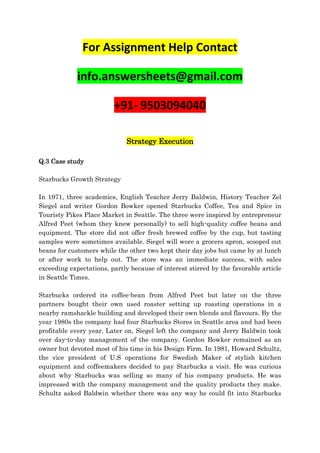
IIBMS DMS CASE STUDY SOLUTIONS-What problems might arise from Starbucks’ efforts to expand rapidly into.docx
- 1. For Assignment Help Contact info.answersheets@gmail.com +91- 9503094040 Strategy Execution Q.3 Case study Starbucks Growth Strategy In 1971, three academics, English Teacher Jerry Baldwin, History Teacher Zel Siegel and writer Gordon Bowker opened Starbucks Coffee, Tea and Spice in Touristy Pikes Place Market in Seattle. The three were inspired by entrepreneur Alfred Peet (whom they knew personally) to sell high-quality coffee beans and equipment. The store did not offer fresh brewed coffee by the cup, but tasting samples were sometimes available. Siegel will wore a grocers apron, scooped out beans for customers while the other two kept their day jobs but came by at lunch or after work to help out. The store was an immediate success, with sales exceeding expectations, partly because of interest stirred by the favorable article in Seattle Times. Starbucks ordered its coffee-bean from Alfred Peet but later on the three partners bought their own used roaster setting up roasting operations in a nearby ramshackle building and developed their own blends and flavours. By the year 1980s the company had four Starbucks Stores in Seattle area and had been profitable every year. Later on, Siegel left the company and Jerry Baldwin took over day-to-day management of the company. Gordon Bowker remained as an owner but devoted most of his time in his Design Firm. In 1981, Howard Schultz, the vice president of U.S operations for Swedish Maker of stylish kitchen equipment and coffeemakers decided to pay Starbucks a visit. He was curious about why Starbucks was selling so many of his company products. He was impressed with the company management and the quality products they make. Schultz asked Baldwin whether there was any way he could fit into Starbucks
- 2. and it took long time to decide his request. He tried many times till one day he was given a job of heading marketing and overseeing the retail stores. Howard Schultz spent most of his working hours in the four stores learning the retail aspects of the company business; Schultz was overflowing with ideas for the company. His biggest inspiration and vision for Starbucks future came during 1983 when the company sent him for an international house wares show to Milan, Italy. There he spotted an espresso bar and went to take a coffee. He was impressed with the coffeehouse services and decided to stay at Milan for a week to explore all coffee bars and learned as much as he could about the Italian passion for coffee drinks. He made a decision to serve fresh brewed coffee, espressos, and cappuccinos in its stores and try to create an American version of Italian coffee bar culture. He shared his idea with Baldwin and it took nearly a year to convince Jerry Baldwin to let him test an espresso bar. In April 1984, the first espresso bar was opened and it was a successful too. Yet Baldwin felt something is wrong. After Schultz failed to convince Baldwin for the expansion of Business, he left Starbucks in 1985. Schultz started the “Il Giornale” coffee bar chain in 1985 and the coffeehouse was very successful. In 1987 Starbucks owner Jerry Baldwin and Bowker decide to sell the whole Starbucks chain to Schultz’s Il Giornale, which rebranded the Il Giornale outlets as Starbucks and quickly began to expand. Starbucks opened its first locations outside Seattle at Waterfront Station in Vancouver, British Columbia, and Chicago, Illinois, that same year. At the time of its initial public offering on the stock market in 1992, Starbucks had grown to 165 outlets. In 2009 The Company plans to open a net of 900 new stores outside of the United States. Today, Starbucks coffee shops and Kiosks can be found in a variety of shopping centres, office buildings, bookstores, and other outlets. Starbucks is capitalizing on taste changes that predate the company’s founding. In the early 1960’s, American adults consumed on an average of three cups of coffee each day. Today, consumption has declined to less than two cups, with only half of American adults as coffee drinkers. During this time, decaffeinated coffee sales soared. In addition, a new category of intensely loyal coffee drinkers was born. This group of adults consumes “specialty” or “premium” coffees, including regular and decaffeinated versions with a variety of origins and flavours. Sales of specialty coffee have climbed from about $45 million annually to more than $2 billion today, accounting, for about 20 percent of all coffee sales. Because Starbucks markets whole beans and coffee beverages, its competition comes from two distinct groups of firms. A number of regional coffee manufacturers distribute premium coffees in local markets, while several large national coffee manufacturers such as Nestle, Proctor & Gamble, and Kraft
- 3. General Foods market and distribution specialty coffees in supermarkets. Coffee beverages are distributes by restaurants, grocery stores, and coffee retailers. Seattle’s Best Coffee is a fierce competitor. Chairman Howard Schultz projects that Starbucks will grow from its present 6,000 stores to more than 20,000, 75 percent of which are in the Unites States. The company added 280 intentional locations in 2001 and is targeting an additional 650 stores in Europe by 2004 and 900 locations in Latin America predominantly Mexico by 2005, Starbucks is also moving into China. Retail stores account for more than 80 percent of revenues, with specialty operations accounting for the remainder. Question: (5 × 4 = 20) 1. What are some of the challenges associated with Starbucks Aggressive? Growth strategy? 2. Could an unanticipated change in coffee consumption patterns disrupt? Starbucks in the same way that it paved the way for the company’s growth in the 1980s? 3. What problems might arise from Starbucks’ efforts to expand rapidly into Nations such as India? 4. Comment on the pricing strategies of Starbucks. 5. How would you see the competition of Starbucks in India, with players Like Costa Coffee? For Assignment Help Contact info.answersheets@gmail.com +91- 9503094040